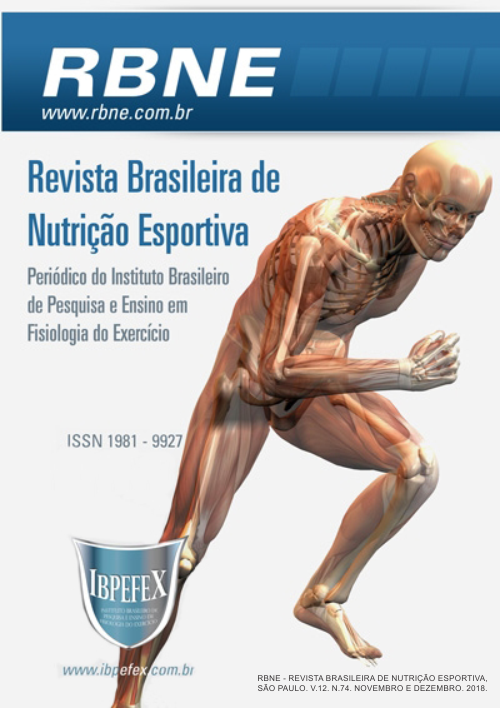Relationship between food consumption, physical exercise and primary dismenorrhea in women aged 18 to 40 years in Belém-PA
Abstract
Introduction: Primary dysmenorrhea is one of the main complaints among 50 to 90% of the women, being usually accompanied by other symptoms that compromise their daily activities. Because diet and physical exercise contribute to a number of benefits, such as the reduction of chronic non-communicable diseases, it is important to check whether food consumption and physical activity benefit in improving the picture. Objective: To analyze the relationship between dietary intake, physical exercise and primary dysmenorrhoea. Materials and Methods: Fifty volunteers were evaluated, 25 of the control group with sedentary women and 25 physical exercise practitioners. A questionnaire was applied with questions related to food consumption and exercise. To verify the intensity of menstrual cramps, the Visual Analog Pain Scale (EVA) was used according to Collins et al. (1997). Discussion: Women who practiced physical exercise had a lower intensity in menstrual colic when compared to sedentary women. Regarding the food consumption of the interviewees, there was a higher prevalence for sweet foods (chocolate), both sedentary and physical exercise. Results: It can be observed that 88% of the physical exercise practitioners reported feeling the intensity of the colic between mild and moderate, and of the sedentary women, 92% reported feeling the intensity of moderate to intense. 80% of the women interviewed in both groups reported preference for sweet foods, this being chocolate. There were no significant correlations between the variables. Conclusion: The regular practice of physical exercise and a balanced diet are positive strategies to ameliorate the symptoms inherent to primary dysmenorrhea.
References
-Almeida, A.P.F.; Assis, M.M.; Efeitos colaterais e alterações fisiológicas relacionadas ao uso contínuo de anticoncepcionais hormonais orais. Rev. Eletrôn. Atualiza Saúde/Salvador. Vol. 5. 2017.
-Araújo, L.M.; Silva, M.N.; Bastos, T.W.; Ventura, P.L. Diminuição da dor em mulheres com dismenorreia primária, tratadas pelo método Pilates. Revista de São Paulo. 2012.
-Barreiros, F.F. Alimentação, Stress e Ciclo Menstrual. Universidade Fernando Pessoa Faculdade de Ciências da Saúde Porto. 2015.
-Bruinsma, K.; Taren, D.L. Chocolate: Food or Drug? Journal of the American Dietetic Association. Vol. 99. Num. 10. 1999. p.1249-1256.
-Cardoso, T.S.M.; Leme A.P.C.B.P. A equivalência da dança do ventre á cinesioterapia terapêutica da dismenorréia primária. Rev. fisio. Bras. 2003.
-Cross, G.B.; Marley, J.; Miles, H.; Wilson, K. Changes in nutrient intake during the menstrual cycle of overweight women with premenstrual syndorme. British Journal of Nutrition. Vol. 85. Num. 4. 2001. p. 457-482.
-Dirce, R.O.; Audrey, H.B.; Laura G.D; Patricia, S.D.; Dayanne A.B.; Luana C.S. Síndrome pré-menstrual e aspectos relacionados à antropometria e ao comportamento alimentar. O Mundo da Saúde. São Paulo, 2013.
-Favero, P.O.; Estudo sobre o transtorno disfôrico pré-menstrual. Revista Universo da Enfermagem. Vol. 3. Núm. 2. 2014. p. 77-79.
-Fonseca, J.M.A.; Radmann, C.S.; Carvalho, F.T.; Mesquita, L.S.A. A influência do método Pilates na flexibilidade muscular, sintomas e qualidade de vida em mulheres com dismenorreia primária. Sci Med. 2016.
-Ikeda, F.; Salomão, A.J.; Ramos, L.O. Dismenorréia primária. RBM 1999.
-López, M.L. Aspectos Nutricionais e metabólicos na tensão pré-menstrual. Porto Alegre. 2013.
-Nunes, N. Prevalência de dismenorreia em universitárias e sua relação com absenteísmo escolar, exercício físico e uso de medicamentos. Revista Brasileira Promoção de Saúde. Fortaleza. 2013.
-Oliveira, D.R.; Bicalho, A.H.; Davis, L.G.; Davis, P.S.; Brito, D.A.A.; Santos, L. C. Síndrome pré-menstrual e aspectos relacionados à antropometria e ao comportamento alimentar. O Mundo da Saúde. Vol. 37. Num. 3. 2013. p. 13-21.
-Pedregal, K.A.; Medeiros, K.B.; Silva, J.A. Análise da força muscular e escolhas dietéticas de mulheres fisicamente ativas durante o ciclo menstrual. Revista Brasileira de Nutrição Esportiva. São Paulo. Vol. 11. Núm. 64. 2017. p. 13-21. Disponível em: <http://www.rbne.com.br/index.php/rbne/article/view/847>
-Peruzzo, B.C.T.; Ramalho, L.S.; Figueiredo, M.R.; Alfieri, F.M.; Benefícios sobre a intensidade da dor, qualidade de vida e incapacidade de mulheres com dismenorreia submetidas a exercícios gerais versus método de Pilates: estudo-piloto. ABCS Health Sci. 2015.
Authors who publish in this journal agree to the following terms:
- Authors retain the copyright and grant the journal the right of first publication, with work simultaneously licensed under the Creative Commons Attribution License BY-NC which allows the sharing of the work with acknowledgment of the authorship of the work and initial publication in this journal.
- Authors are authorized to enter into additional contracts separately for non-exclusive distribution of the version of the work published in this journal (eg, publishing in institutional repository or book chapter), with acknowledgment of authorship and initial publication in this journal.
- Authors are allowed and encouraged to post and distribute their work online (eg, in institutional repositories or on their personal page) at any point before or during the editorial process, as this can bring about productive change as well as increase impact and impact. citation of published work (See The Effect of Free Access).






